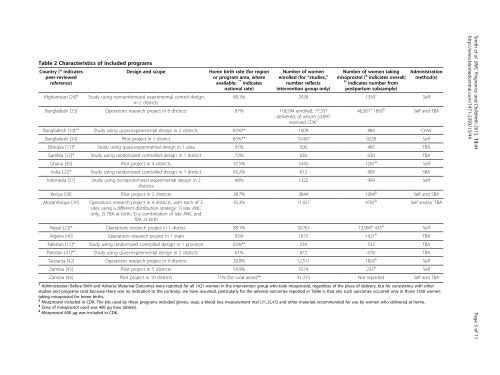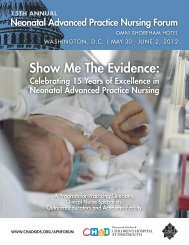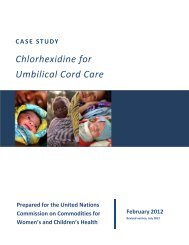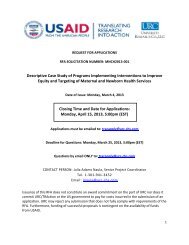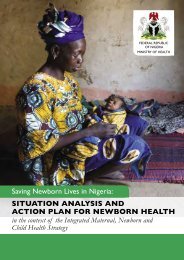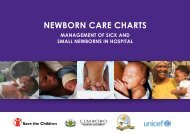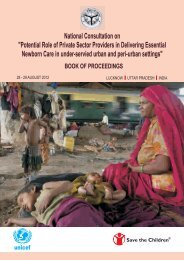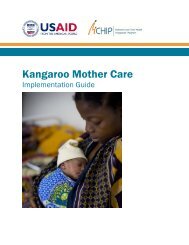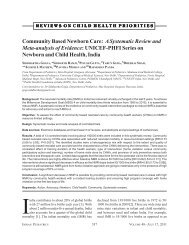Misoprostol for postpartum hemorrhage prevention ... - BioMed Central
Misoprostol for postpartum hemorrhage prevention ... - BioMed Central
Misoprostol for postpartum hemorrhage prevention ... - BioMed Central
You also want an ePaper? Increase the reach of your titles
YUMPU automatically turns print PDFs into web optimized ePapers that Google loves.
Table 2 Characteristics of included programsCountry (* indicatespeer-reviewedreference)Design and scopeHome birth rate (<strong>for</strong> regionor program area, whereavailable; ** indicatesnational rate)Number of womenenrolled (<strong>for</strong> “studies,”number reflectsintervention group only)Number of women takingmisoprostol ( a indicates overall;b indicates number from<strong>postpartum</strong> subsample)Administrationmethod(s)Afghanistan [24]* Study using nonrandomized experimental control design80.1% 2039 1350 1 Selfin 2 districtsBangladesh [33] Operations research project in 6 districts 87% 118,594 enrolled; 77,337delivered, of whom 53,897received CDK 2 46,561 a 1893 b Self and TBABangladesh [14]* 3 Study using quasi-experimental design in 2 districts 85%** 1009 884 CHWBangladesh [34] Pilot project in 1 district 85%** 19,497 9228 SelfEthiopia [13]* Study using quasi-experimental design in 1 area 97% 500 485 TBAGambia [35]* Study using randomized controlled design in 1 district 72% 630 630 TBAGhana [36] Pilot project in 4 districts 37.5% 5345 1261 b SelfIndia [22]* Study using randomized controlled design in 1 district 45.2% 812 809 SBAIndonesia [37] Study using nonrandomized experimental design in 248% 1322 999 SelfdistrictsKenya [38] Pilot project in 2 districts 38.7% 3844 1084 b Self and SBAMozambique [39] Operations research project in 4 districts, with each of 3sites using a different distribution strategy: 1) late ANConly, 2) TBA at birth, 3) a combination of late ANC andTBA at birth35.3% 11,927 4781 b Self and/or TBANepal [23]* Operations research project in 1 district 89.1% 18,761 13,969 a 435 b SelfNigeria [40] Operations research project in 1 state 95% 1875 1421 b TBAPakistan [15]* Study using randomized controlled design in 1 province 65%** 534 533 TBAPakistan [41]* 4 Study using quasi-experimental design in 2 districts 61% 872 678 TBATanzania [42] Operations research project in 4 districts 30.8% 12,511 1826 b SelfZambia [43] Pilot project in 5 districts 59.9% 5574 233 b SelfZambia [44] Pilot project in 10 districts 71% (<strong>for</strong> rural areas)** 31,315 Not reported Self and TBA1 Administration Be<strong>for</strong>e Birth and Adverse Maternal Outcomes were reported <strong>for</strong> all 1421 women in the intervention group who took misoprostol, regardless of the place of delivery, but <strong>for</strong> consistency with otherstudies and programs (and because there was no indication to the contrary), we have assumed, particularly <strong>for</strong> the adverse outcomes reported in Table 6, that any such outcomes occurred only in those 1350 womentaking misoprostol <strong>for</strong> home births.2 <strong>Misoprostol</strong> included in CDK. The kits used by these programs included gloves, soap, a blood loss measurement mat [31,32,45] and other materials recommended <strong>for</strong> use by women who delivered at home.3 Dose of misoprostol used was 400 μg (two tablets).4 <strong>Misoprostol</strong> 600 μg was included in CDK.Smith et al. BMC Pregnancy and Childbirth 2013, 13:44 Page 5 of 11http://www.biomedcentral.com/1471-2393/13/44


